
Pasta is a type of food typically made from an unleavened dough of wheat flour mixed with water or eggs, and formed into sheets or other shapes, then cooked by boiling or baking. Pasta was traditionally only made with durum, although the definition has been expanded to include alternatives for a gluten-free diet, such as rice flour, or legumes such as beans or lentils. While Asian noodles are believed to have originated in China, pasta is believed to have independently originated in Italy and is a staple food of Italian cuisine, with evidence of Etruscans making pasta as early as 400 BCE in Italy.
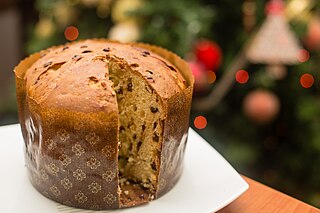
Panettone is an Italian type of sweet bread and fruitcake, originally from Milan, Italy, usually prepared and enjoyed for Christmas and New Year in Western, Southern, and Southeastern Europe, as well as in South America, Eritrea, Australia, the United States and Canada.

Pane carasau is a traditional flatbread from Sardinia. It is called carta da musica in Italian, meaning 'sheet music', in reference to its large and paper-thin shape, which is said to be so thin before cooking that a sheet of music can be read through it. It is typically paired with pecorino cheese and wine.

Emmer wheat or hulled wheat is a type of awned wheat. Emmer is a tetraploid. The domesticated types are Triticum turgidum subsp. dicoccum and T. t. conv. durum. The wild plant is called T. t. subsp. dicoccoides. The principal difference between the wild and the domestic forms is that the ripened seed head of the wild plant shatters and scatters the seed onto the ground, while in the domesticated emmer, the seed head remains intact, thus making it easier for humans to harvest the grain.
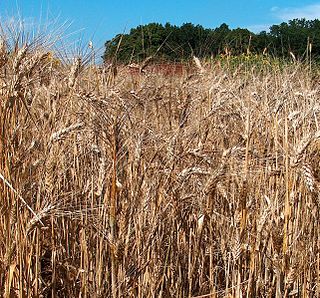
Durum wheat, also called pasta wheat or macaroni wheat, is a tetraploid species of wheat. It is the second most cultivated species of wheat after common wheat, although it represents only 5% to 8% of global wheat production. It was developed by artificial selection of the domesticated emmer wheat strains formerly grown in Central Europe and the Near East around 7000 BC, which developed a naked, free-threshing form. Like emmer, durum wheat is awned. It is the predominant wheat that grows in the Middle East.

Spätzle ( ), or nokedli in Hungarian, are a type of Central European egg noodles typically served as a side for meat dishes with sauce. Commonly associated with Swabia and Alsace, it is also found in the cuisines of southern Germany and Austria, Switzerland, Liechtenstein, Hungary, Vojvodina, Slovenia, Lorraine, Moselle and South Tyrol.

Semolina is the name given to coarsely milled durum wheat mainly used in making couscous, pasta, and sweet puddings. The term semolina is also used to designate coarse millings of other varieties of wheat, and sometimes other grains as well.

Focaccia is a flat leavened oven-baked Italian bread. In some contemporary places, such as Rome, it is a style of pizza, also called pizza bianca. Focaccia may be served as a side dish or as sandwich bread and it may be round, rectangular, or square shape.
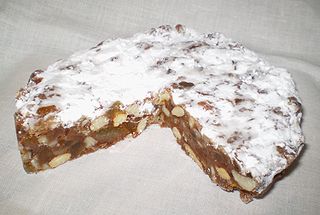
Panforte is a traditional chewy Italian dessert containing fruits and nuts. It is similar to a florentine but much thicker, or a little like a lebkuchen. Known throughout all Italy, it is a Christmas tradition associated most especially with the province of Siena.

A flatbread is bread made usually with flour; water, milk, yogurt, or other liquid; and salt, and then thoroughly rolled into flattened dough. Many flatbreads are unleavened, although some are leavened, such as pita bread.

In many European countries, particularly in Central and Eastern Europe, there are various traditions surrounding the use of bread during the Easter holidays. Traditionally the practice of eating Easter bread or sweetened "communion" bread traces its origin back to Byzantium, Eastern Catholicism and the Orthodox Christian church. The recipe for sweetened or "honey-leavened" bread may date back as far as the Homeric Greek period based on anecdotal evidence from classical texts.
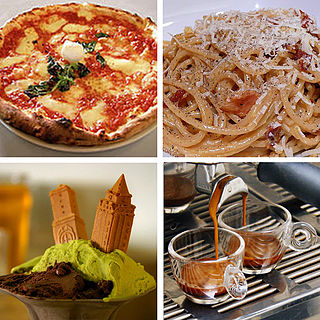
Italian cuisine is a Mediterranean cuisine consisting of the ingredients, recipes and cooking techniques developed in Italy since Roman times and later spread around the world together with waves of Italian diaspora. Some of these foods were imported from other cultures. Significant changes occurred with the colonization of the Americas and the introduction of potatoes, tomatoes, capsicums, maize and sugar beet—the latter introduced in quantity in the 18th century. It is one of the best-known and most appreciated gastronomies worldwide.
Laurenzana is a town and comune in the province of Potenza, in the region of Basilicata. It rises on a spur between the torre Camastro and the wood surrounding the Serrapotamo valley.
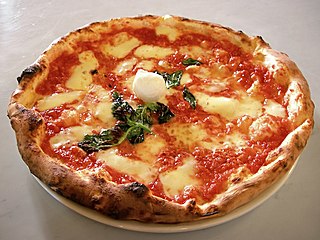
Neapolitan pizza, also known as Naples-style pizza, is a style of pizza made with tomatoes and mozzarella cheese. The tomatoes must be either San Marzano tomatoes or pomodorini del Piennolo del Vesuvio, which grow on the volcanic plains to the south of Mount Vesuvius. The cheese must be mozzarella di bufala campana, a protected designation of origin cheese made with the milk from water buffalo raised in the marshlands of Campania and Lazio in a semi-wild state, or fior di latte, a cow's milk mozzarella created according to the procedure for which it was registered as a traditional speciality guaranteed (TSG). Pizza napoletana is a TSG product in the European Union and the United Kingdom, and the art of its making is included on UNESCO's list of intangible cultural heritage.

The cuisine of Sardinia is the traditional cuisine of the island of Sardinia, and the expression of its culinary art. It is characterised by its own variety, and by the fact of having been enriched through a number of interactions with the other Mediterranean cultures while retaining its own identity. Sardinia's food culture is strictly divided into food from the land and food from the sea, reflecting the island's historical vicissitudes and especially its geographic landscapes, spacing from the coastline to the ragged mountains of the interior. The Sardinian cuisine is considered part of the Mediterranean diet, a nutritional model that was proclaimed by UNESCO as an intangible cultural heritage.
Bread is a staple food throughout Europe. Throughout the 20th century, there was a huge increase in global production, mainly due to a rise in available, developed land throughout Europe, North America and Africa.

Pane di Laterza is a traditional bread of Laterza, a comune (municipality) in the province of Taranto, Apulia. It is made with durum flour with water, salt and sourdough. It is mainly produced in Laterza, but it can be also found in neighbouring municipalities. It has been recognised by the Italian Ministry of the Agriculture, Food and Forestry Policies as prodotto agroalimentare tradizionale (PAT) of Apulia.

Apulian cuisine consists of the cooking traditions and practices of the region of Apulia in Italy. Starting from the Middle Ages the permanent residence of the nobility in the region gradually declined, which caused the disappearance of their noble cuisine over time. As the common people suffered from poverty, their culinary tradition adapted to use cheap and simple foods. Bread, vegetables and pasta have the leading role in the cuisine. Fruits, fish and wine are consumed frequently as well, but meat plays a minor role. The food of Apulia is known as a prime example of cucina povera or 'cuisine of the poor', characterizing its simplicity rather than its quality. Moreover, the simple dishes allow the quality of their local and seasonal ingredients to take center stage.

Bread in Spain has an ancient tradition with various preparations in each region. Wheat is by far the most cultivated cereal, as it withstands the dry climate of the interior of the country. Since time immemorial, bread is a staple food that accompanies all daily meals, all year round. In fact, the Iberian Peninsula is one of the European regions with the greatest diversity of breads. The Spanish gourmet José Carlos Capel estimated a total of 315 varieties of bread in Spain, although the barra is, by far, the most consumed variety of bread (75%). In addition to food, bread in Spain has a historical, cultural, religious and mythological function.

















